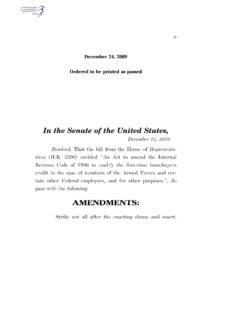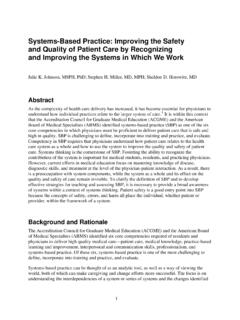Transcription of A Framework for Patient-Centered Health Risk Assessments
1 CS 228668-AA Framework for Patient-Centered Health Risk AssessmentsProviding Health Promotion and Disease Prevention Services to Medicare BeneficiariesA Framework for Patient-Centered Health Risk AssessmentsProviding Health Promotion and Disease Prevention Services to Medicare BeneficiariesRon Z. Goetzel, PhD2,3; Paula Staley, MPA, RN1; Lydia Ogden, PhD, MPP1,2; Paul Stange, MPH1; Jared Fox, PhD, MPP1; Jason Spangler, MD, MPH4; Maryam Tabrizi, MS3; Meghan Beckowski, MPH3; Niranjana Kowlessar, PhD3; Russell E. Glasgow, PhD5; Martina V. Taylor, MT(ASCP)5; Chesley Richards, MD, for Disease Control and Prevention, Atlanta, GA; 2 Rollins School of Public Health , Emory University, Atlanta, GA; 3 Thomson Reuters, 4301 Connecticut Ave., NW Suite 330, Washington, DC 20008; 4 Partnership for Prevention, 1015 18th Street, NW, Suite 300, Washington, DC 20036; 5 National Institutes of Health , Bethesda, MD 20892 Suggested Citation:Goetzel, RZ; Staley, P; Ogden, L; Stange, P; Fox, J; Spangler, J; Tabrizi, M; Beckowski, M; Kowlessar, N; Glasgow ,RE, Taylor, MV.
2 A Framework for Patient-Centered Health risk Assessments providing Health promotion and disease prevention services to Medicare beneficiaries. Atlanta, GA: US Department of Health and Human Services, Centers for Disease Control and Prevention, 2011. Available at: ..7 Summary .. of HRAs and Follow-Up Interventions as Part of the Medicare Annual Wellness the HRA Plus of HRA Plus Services ..19 History of Health Risk 19 Methods: The Development ..35 Appendix ..417 AcknowledgmentsCDC Acknowledgment The work of the following external experts and internal CDC subject matter experts, public forum panelists, and CDC internal workgroup members in the development of this document is recognized and Work Group MembersDavid Anderson, PhD, LP, Senior Vice President and Chief Health Officer, StayWell Health ManagementLarry S. Chapman, MPH, President and CEO, Chapman InstituteBasit Chaudhry, MD, PhD, Senior Researcher, Clinical Transformation, Healthcare Analytics, IBM ResearchAmy Compton-Phillips MD, Associate Executive Director, Quality, The Permanente Federation (Kaiser Permanente)Dee Edington, PhD, Professor of Movement Science, School of Kinesiology, University of MichiganJames Fries, MD, Professor Emeritus, Medicine - Immunology & Rheumatology, Stanford University School of MedicineDavid C.
3 Grossman, MD, MPH, Group Health Pediatrician and Medical Director of Preventive Care, Group Health CooperativeDon Hall, DrPH, CHES, Founder and Chief Development Architect, Wellsource, C. Kibbe, MD, MBA, Principal, The Kibbe Group LLC and Senior Advisor, Center for Health Information Technology, American Academy of Family PhysiciansAlex Krist, MD, MPH, Department of Family Medicine, Virginia Commonwealth UniversityRon Loeppke, MD, MPH, Vice-Chairman, Preventive MedicineRonald J. Ozminkowski, PhD, Vice President, Healthcare Information and Innovation, Ingenix (United- Health )Nico Pronk, PhD, FACSM, Senior Investigator, HealthPartners Research Foundation and Vice President for Health Management and Health Science Officer for JourneyWellCary Sennett, MD, PhD, Fellow, Economic Studies and Managing Director for Health Care Finance Reform, Engelberg Center for Health Care Reform, Brookings Institution (participated in former position as Chief Medical Officer, MedAssurant Inc.)Brenna Haviland Shebel, CHES, Assistant Director, Institute on Health Care Costs and Solutions, National Business Group on HealthAlan P.
4 Spielman, MBA, President and CEO, URAC8 Victor J. Strecher, PhD, Professor, Health Behavior & Health Education; Director, Health Media Research Laboratory; Director, Cancer Prevention and Control, University of Michigan School of Public Health ; and Chairman & Founder of HealthMedia, Inc. Jennifer K. Taylor, PhD, Director, Team Leader, Clinical Operations & Evaluation, Corporate & Government Customers, Pfizer IncSarah Thomas, MS, Vice President, Public Policy and Communications, National Committee for Quality Assurance John H. Wasson, MD, Professor of Community and Family Medicine and Herman O. West Professor of Geriatrics, Department of Community and Family Medicine, Dartmouth Medical SchoolDennis White MS, MBA, Senior Vice President of Value-Based Purchasing, National Business Coalition on HealthEric Zimmerman, MPH, MBA, Chief Marketing Officer, Redbrick HealthCDC Internal Workgroup MembersNational Center for Chronic Disease Prevention and Health PromotionLynda Anderson, PhDLaurie Barker, MSPHD jenaba Joseph, MD, MPHD aphna Kanny, PhD Felipe Lobelo, MD, PhDAbby Rosenthal, MPHN ational Center for Birth Defects and Developmental Disabilities Vincent A.
5 Campbell, PhDRuth Perou, PhD David J. Thurman, MD, MPHN ational Center for Immunization and Respiratory DiseasesRay Strikas, MD, MPH, FACP9 National Center for Injury Prevention and ControlDaniel Hungerford, DrPHRebecca Naumann, MSPHJudy Stevens, PhDNational Center for HIV/AIDS, Viral Hepatitis, STD, and TB PreventionStuart Berman, MD, ScMPublic Health Informatics and Technology OfficeSeth Foldy, MD, MPHN inad Mishra, MD, MS 1011 SummaryIn this report, we provide an evidence-informed Framework for providers, policymakers, Health plans, payers, researchers, and vendors on the implementation of Patient-Centered Health risk Assessments (HRAs), follow-up activities, and monitoring of progress toward achiev-ing Health improvement goals (referred to in the literature as the HRA Plus process). The Centers for Disease Control and Prevention (CDC) developed this Framework on the basis of three recently conducted systematic litera-ture reviews and expert input from physicians, researchers, members of medical associations, wellness program developers, and CDC subject matter experts.
6 Expert opinion was used where the evidence base was limited. This Framework is targeted at Medicare beneficiaries 65 years and older but can also be applied to younger beneficiaries. The CDC recommendations aim to achieve the following goals: 1. Provide guidance to providers offering clinical preventive care, Health promotion, and disease management services on ways to use HRAs followed by evidence-based Health improvement programs. 2. Ultimately, reduce Health disparities through the use of HRAs and follow-up interventions that are linguistically and culturally tailored and are available to persons with disabilities. 3. Ultimately, improve Health outcomes by identifying patients modifiable Health risks and providing follow-up behavior change interventions that are implemented over Framework addresses the content and design of HRAs and the context of delivery. IntroductionChronic illnesses account for an estimated 83% of total Health spending and virtually all (99%) of Medicare s expenditures are for benefi-ciaries with at least one chronic condition.
7 (1) Rising rates of certain chronic illnesses such as hyperlipidemia, hypertension, and diabetes often caused by modifiable risk factors such as obesity are not well managed (2-5), and are associated with significant spending increases, particularly for Medicare beneficiaries.(6, 7) Despite national Health expenditures total-ing $ trillion in 2011, many patients do not receive recommended preventive services and follow-up treatment. (8, 9)Among adults aged 65 years and older, only 33% of women and 40% of men are up to date with all age-specific recommended preventive services (10), and fewer than a quarter of adults aged 50 to 64 years are up to date in receiving these services.(11) Further, detection, treat-ment, and control rates for common prevent-able conditions are deficient. For example, almost a third ( ) of adults have hypertension, but more than a fifth ( ) of adults with hypertension are unaware of their condition. Although two thirds of patients with high blood pressure ( ) are screened in a doctor s office and, of those diagnosed, two thirds (70%) are on medication, hypertension is controlled in fewer than half of diagnosed patients ( ).
8 (12) For three decades, the top three leading causes of death in the United States have been, in order, heart disease, cancer, and stroke all amenable to prevention efforts delivered to populations and individual patients .(13, 14) Effective primary preven-tion to avert disease, secondary prevention to detect illness early and intervene, and tertiary prevention to better manage acute and chronic 12conditions are essential to improve the Health and quality of life of Americans. Additionally, effective Health promotion and disease preven-tion practices promise to reduce unnecessary healthcare utilization and increase the value in Health spending.(15) The patient protection and Affordable Care Act of 2010 (Affordable Care Act) included several provisions intended to improve the Health of Americans and prevent the onset of prevent-able chronic conditions.(16) Section 4103 of the Affordable Care Act, the Medicare Coverage of Annual Wellness Visit Providing a Personalized Prevention Plan, establishes a Medicare Annual Wellness Visit beginning in 2011 that includes a Health Risk Assessment (HRA) and a customized wellness or personal prevention plan, without cost to beneficiaries ( , not subject to deduct-ibles or co-pays).
9 (17) This new benefit supple-ments the Welcome to Medicare preventive visit, a one-time, comprehensive assessment offered to beneficiaries within the first 12 months of enrolling in Medicare. The Annual Wellness Visit includes in part a medical history, the development of a preventive screening schedule, and personalized Health planning. Section 4104 authorizes no cost sharing in Medicare for adult preventive services graded A or B by the Preventive Services Task Force (USPSTF). The USPSTF-graded services are available at: As part of the Annual Wellness Visit, an HRA may be completed before, or as part of, a visit with a Health professional who may be a physician, (as defined in section 1861(r)(1) of the Social Security Act), physician s assistant, nurse practitioner, or clinical nurse specialist (as defined in section 1861(aa)(5) of the SSA or medical professional, [ , Health educator, registered dietician, nutrition professional], or other licensed practioner), or a team of such medical professionals working under the direc-tion supervision of a physican.
10 The law specifies that the HRA guidelines will be developed to provide that HRAs 1) identify chronic diseases, injury risks, modifiable risk factors, and urgent Health needs of an individual; 2) may be furnished through an interactive telephonic or web-based program; 3) may be offered during the encounter with a healthcare professional or through community-based prevention programs, or 4) may be provided through any other means the Secretary determines appro-priate to maximize accessibility and ease of use by beneficiaries, while ensuring the privacy of beneficiaries. Other provisions of Section 4103 include 1) establishing standards for interactive, telephonic, or web-based programs used to furnish HRAs, and 2) determining ways of using the HRA in the formulation of a personalized prevention plan for beneficiaries. The law requires making available to the public an HRA model, ensuring that HRAs are easily acces-sible to beneficiaries, providing support to those wishing to complete HRAs, and publiciz-ing the requirement that beneficiaries complete 13an HRA prior to, or concurrent with, receiving personalized prevention plan services.














